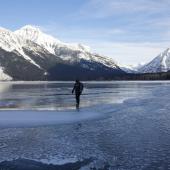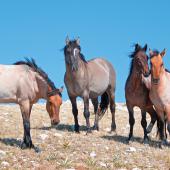Sweet Grass Hills Legends
Napi, the Old Man, created the Earth, the Oceans, and the Backbone of the World; the Rocky Mountains. According to Blackfoot tradition, Napi then took the leftover earth and rock from his pockets and created the Sweetgrass Hills. Located across North Central Montana, in Toole and Liberty counties, these mountain islands hold secrets only the gods know. Steeped in historical and religious connotations, the Sweetgrass Hills are distinctly Montana.

Looking north while along the Hi-Line between Shelby and Chester, the viewer will see three distinct buttes; West Butte, Middle Butte, and East Butte. Healthy sprouts of winter wheat line the fields on either side of the dirt road, while most remaining buildings look abandoned and wind worn. Located about 40 miles north of each town, as one gets closer we can also see the smaller Haystack and Grassy Butte, and then that the East Butte area is really multiple mountains. Many elk, antelope, and varieties of birds live around these mountains, but not many people.
A gold rush came once, a century ago, earning Middle Butte a new name of Gold Butte. The mining town once boasted 500 people, a school, hotel, and saloon, but only a cemetery remains today. When the miners left, the free range cattle businesses moved in. Charlie Russell, the great Montana artist, even tried his hand at ranching in the area. The Lazy KY Ranch near Gold Butte later became a beautiful watercolor painting. Later, thousands of homesteaders rushed the area in search of free land, but only a few were successful. The strong few who today call this place home will attest to the spirituality of the hills.

Perhaps those with the strongest connection to the mountains are members of the Blackfoot tribe. The areas around the hills was once their homeland, and a view from atop the buttes could easily track the massive buffalo herds. In their legends, the only location named in their creation story is the Katoyisiks. The Sweetgrass Hills were once named for the famous hero Katoyis, who slay the wind-sucker monster atop one of these buttes. An ancient vision quest to the top of these mountains led to the discovery of the Sun Dance. The hills were sacred friends, as the gods asked the hills to swallow the bison, to save them from the rifles of the buffalo hunters. But of the many stories associated with these hills, this Chippewa-Cree legend might be the most amazing.
Like many other cultures, the Chippewa-Cree have a legend associated with the great floods of the world. To survive the flood waters the god fled to the Sweetgrass Hills, and to a specific location within the hills. Inside a warm cave the god waited out the rising waters, and from there he reformed and restructured the flooded world. That place exists to this day. The Devil’s Chimney is a small cave that just might be the greatest, unknown religious site in Montana.

After a strenuous hike, one must be willing to get down and dirty to enter the chamber. The main entrance to the cave is the wide chimney atop the rocky chamber, but only the nesting hawks use that entrance. To enter one must crawl like a badger through a portal into the cave. Flashlights are unneeded, as the misty, green interior is highlighted by the overhead entrances. A mysterious, forbidding shelter, a place where we can imagine a camping pits once existing, bellowing smoke from the chimney. Not a bad spot to wait out a flood, and after squirming out through the portal, one almost feels reborn, with one’s first sight being Montana’s Sweetgrass Hills.
Each of the buttes overlook giant treeless plains, checkered with croplands. The East Butte hills, whether rocky or grassy, gain trees at a certain elevation, but not on the sunny south faces. Rocky outcroppings arise from most of the hills, but especially West Butte. Gravel roads run around these mountains, but direct access is not easy. Furthermore, during this exploration every attempt was made to be respectful to the area. Not only because of the religious nature of the site, but also in regard to private property rights surrounding these hills, and the delicate nature of caves in general. Other caves exist within the Sweetgrass Hills, and like many caves in Montana, they lay undiscovered. Please be mindful when visiting any caves. For more information on caving in Montana please visit nrmg.org.
Lewis and Clark called them the Broken Mountains, the French trappers dubbed them “Les Trois Buttes.” Sunburst, Montana, is named for the morning’s first rays of light cresting above the Sweetgrass Hills. It’s easy to see why Napi choose the Sweetgrass Hills for a sanctuary. The geology and spirituality of the Sweetgrass Hills make them unique in Montana history. The gods created them, so perhaps one day you should visit them.
* * * *
MONTANA CAVE FACTOIDS
Lewis & Clark Caverns: between Whitehall and Three Forks, a beautiful cave offering tours.
Pictograph Cave State Park: southeast of Billings. Rock paintings by pre-historic hunters.
Longest Cave in Montana: Bighorn Cave System, over 14 miles long. Permit required from National Park Service.
Cavers have recorded 350 caves in Montana of lengths longer than 50 feet, including the discovery and documentation of the United States deepest limestone cave: Tears of the Turtle Cave, 1629 feet below the surface.




AREA ATTRACTIONS
Marias River State Park Wildlife Management Area
Marias Museum of History & Art, Shelby, MT
Liberty County Museum, Chester, MT
Glacier National Park is 100 miles west of the Sweetgrass Hills.












Leave a Comment Here